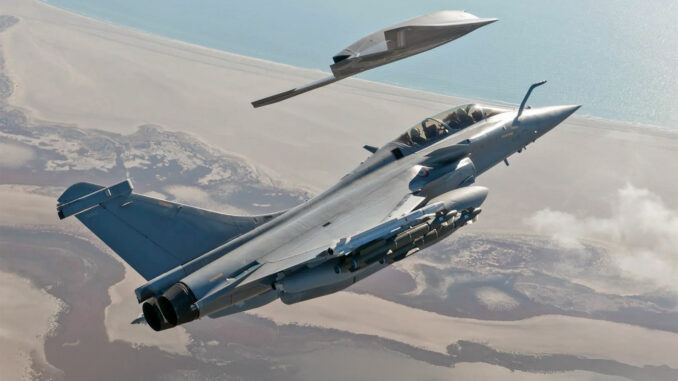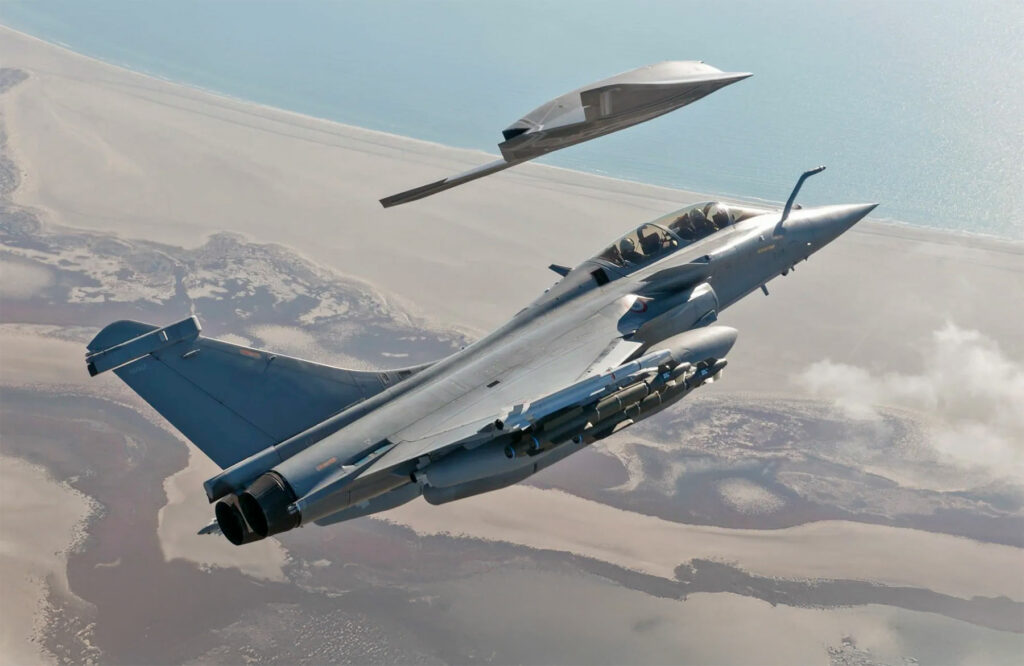
France is developing an uncrewed combat air vehicle (UCAV) to complement the Rafale F5, set for missions starting in 2033.
France has unveiled its plans to develop a new uncrewed combat air vehicle (UCAV) to accompany the future Rafale F5. This drone, inspired by past experiences with the nEUROn demonstrator, will be essential for high-intensity missions by 2033. It will feature stealth characteristics and be capable of operating autonomously while being controlled by a pilot in the Rafale cockpit. This program is part of the modernization of the French Air and Space Force.
An UCAV to Accompany Future French Rafale Fighters
France has announced plans to develop a drone for combat (UCAV) that will complement the upcoming Rafale F5. This initiative was presented during a ceremony marking the 60th anniversary of the Strategic Air Forces (FAS) at Saint-Dizier Air Base by Minister of the Armed Forces Sébastien Lecornu. The drone, which has yet to be named, is designed to work closely with the Rafale and enhance the operational capabilities of the French Air Force by 2033.
The program will be led by Dassault Aviation, which will leverage the experience gained from the nEUROn demonstrator, a stealth combat drone that has already been flight-tested. According to Éric Trappier, CEO of Dassault, this drone is expected to contribute to the technological and operational superiority of the French Armed Forces.
Technical Details About the Drone
The new combat drone will be designed to be complementary to the Rafale and suited for collaborative combat missions. Equipped with stealth characteristics, it will have an internal payload, reducing its radar signature and making it difficult to detect by enemy systems. The drone will also have autonomous control capabilities while allowing a pilot in the Rafale cockpit to interact and oversee its missions.
Details regarding the expected performance and the range of missions the drone will undertake are not yet available. However, it is important to note that this initiative responds to future threats, particularly against potential adversaries using advanced technologies. The drone’s versatility and adaptability will be significant assets for the French Air Force.

Consequences for French Military Superiority
The introduction of this uncrewed combat drone could have a significant impact on France’s military superiority. By working alongside the Rafale F5, the drone could execute surveillance, reconnaissance, and attack missions, thereby reducing risks for pilots during dangerous operations. The drone’s ability to collaborate with the Rafale for combat missions could enhance the overall effectiveness of military operations.
This initiative also responds to the current geopolitical dynamics, where countries are investing in advanced technologies to maintain military power. By developing this drone, France demonstrates its commitment to modernizing its military capabilities and maintaining operational independence. Furthermore, it could encourage other nations to adopt similar technologies, thereby establishing a new standard in military aviation.
Training Pilots for Collaborative Combat
One of the key elements for the success of this program will be the training of pilots on the new systems. Rafale pilots will need to acquire specific skills to operate synergistically with the drone. This will include understanding the communication and control systems that will enable the integration of the drone into missions carried out by the Rafale.
Training will be crucial to maximize operational efficiency and ensure that pilots can fully leverage the capabilities offered by the drone. By preparing pilots to use advanced technologies and understand the drone’s operation, France ensures that its air forces remain at the forefront of technological innovation.
Munitions and Armament Capabilities
The armament capabilities of the combat drone remain to be clarified, but it is likely that it will be designed to use modern munitions suited to the missions it will conduct alongside the Rafale F5. The Rafale F5 itself is expected to incorporate advanced weapon systems, including the ASN4G missile, which will replace the current ASMPA for nuclear deterrence missions.
Additionally, weapon systems such as the conventional cruise missile SCALP and the Exocet anti-ship missile are also planned for the Rafale. The drone’s ability to carry and deploy these weapons in collaboration with the Rafale could significantly enhance the striking power of the French Armed Forces.
By integrating these new armament capabilities, the uncrewed combat drone could become a key element in the strategy of suppression and destruction of enemy air defenses (SEAD/DEAD), thereby enabling the Rafale F5 to conduct bolder and more effective operations.
War Wings Daily is an independant magazine.